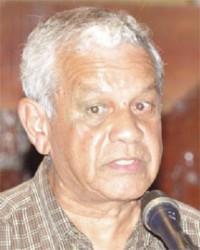Trinidad and Tobago historian Dr Brinsley Samaroo said East Indians made a substantial difference to the evolution of the Caribbean, lending their skills to resuscitate the sugar industry and enriching it with their vibrant culture.
He was delivering a lecture at the Umana Yana last week held to mark the occasion of the 175th anniversary of Indian arrival in Guyana.
Dr Samaroo is a Senior Research Fellow at the Academy of the University of Trinidad and Tobago (UTT) for Arts, Letters, Culture and Public Affairs, a report from the Government Information Agency (GINA) said. His presentation, the first in a series, was held under the theme ‘Making a difference: the East Indian Presence in the Caribbean, 1838-2013’ and hosted at the Umana Yana.

Dr Samaroo noted that Guyana had the largest number of Indian immigrants in the Caribbean out of the 1.3 million labourers who left India for the plantation colonies of the Caribbean. He said they made a significant impact on the Caribbean’s economy replacing a rapidly depleting African labour force. After settling here, a large number of them returned to India because the British government had reneged on a promise to give them land.
However, GINA reported that he said the Indians did not come into an “economic disaster area” as so many persons have wrongfully believed, rather the Africans cleared the jungle and swamps and laid the foundation of the plantation systems upon which the Indians built. The professor also noted that the Indians brought many of their cultural practices, musical instruments, agriculture, jewellery, animals, and decorative craft, among other items.
After 1857, the pace of the Indians’ migration quickened to escape the vengeance of the British, though the trip across 10,000 miles over the Indian and Atlantic oceans was traumatic. About 75 per cent of them remained in the Caribbean making a substantial difference to the evolution of Caribbean civilization. However, from the time they entered the Caribbean, the Indians changed as they had to mix with persons from other classes, religion and race.
Thousands of them also changed their names to better assimilate into their new environment, he said, according to GINA.
Indians made a difference by introducing a different view of the world. They were described as “poor but proud” because they were often barefooted and challenged the Canadian missionaries theologically and quite often the Canadians couldn’t answer them, the professor said.
In brief remarks, Minister of Culture, Dr Frank Anthony spoke about the importance of such lectures to educate Guyanese about their rich cultural backgrounds. He said that Arrival Day represents everyone who came to Guyana as indentured immigrants. “When we speak of Arrival Day we speak about the arrival of our East Indians, Portuguese, Chinese and African ancestors,” Anthony said.
The second lecture will be delivered today at 5 pm at the Umana Yana by Dr Kusha Haraksingh, Dean, Faculty of Law, UWI, St Augustine, Trinidad followed by Gaiutra Bahadur, an American journalist and book critic, on May 21.





